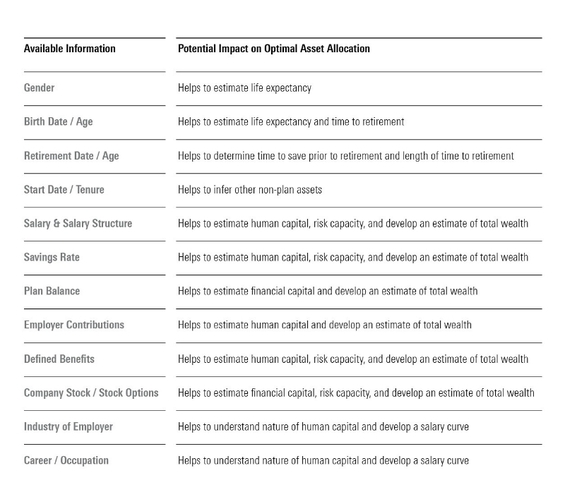Not long ago, demographic data of individual employees, with the exception of compensation information, was largely considered to be inaccessible by employers.
Today, it’s a very different world. Employers have access to an abundance of employee data that can be used to help design a more insightful and impactful retirement benefits package. Advancements in recordkeeping and payroll systems, along with employers’ desire to have this data, has really driven this change.
How employee data can help plan sponsors
This abundance of employee data has given plan sponsors the ability to take a more sophisticated approach to selecting a default investment for their employees’ retirement plan. Readily available data can help them choose plan options that are better suited for the needs of their participants.
So, what data does an employer have?
In my experience, the place to start is the payroll department. The payroll department can usually provide basic demographic details about each employee such as salary, date of birth, gender, and date of hire. This data can then be augmented through the plan’s recordkeeper to add data such as savings rate, 401(k) balance, current company stock amount, and any pension benefits along with other information.
Collecting this data may sound difficult, but plan sponsors typically have access to it through the yearly summaries provided by their recordkeepers, payroll providers, and other institutions.
How employee data can influence asset allocation
By using the employee data available and making a few assumptions (retirement age, for example), plan sponsors can construct a good start to an investing profile for each employee.
The table below shows how certain employee data can influence the optimal asset allocation (stock/bond split) for an employee. It’s important to note that we define human capital as a person’s ability to earn and save throughout his or her life.

Using employee data to choose a default investment
Having these employee details for an entire plan means that an employer could estimate the optimal stock/bond split for each participant and compare that to their participants’ current holdings. This allows employers to make better-informed decisions about their plans’ default investments.
The plan sponsor’s goal would then be to choose a default investment option that minimizes the differences in equity, or “misfit,” between where investors should be invested and where they are currently invested. In our experience, equity misfit can be quite prevalent among defined-contribution plans and can expose investors to too much or too little equity risk. Additionally, it may suggest that the plan’s current default investment may not be an optimal choice.
As employee benefits enter the data age, employers now have the means to use individual employee data to make more informed investment decisions for their participants and help determine which default investment option— target-date fund, custom target-date fund, managed accounts—may be a better fit.
Data informs nearly every major decision employers make, so why not use individual participant data to aid in the default investment decision?
Dan Bruns is a product and investment specialist for the Morningstar Retirement Solutions product group.
Please see below for important disclosure.


